Are LinkedIn ads part of your sales funnel? Wondering how to split test your ads in LinkedIn Campaign Manager?
In this article, you’ll learn how to A/B test LinkedIn ads’ placements, creative, targeting, and more.
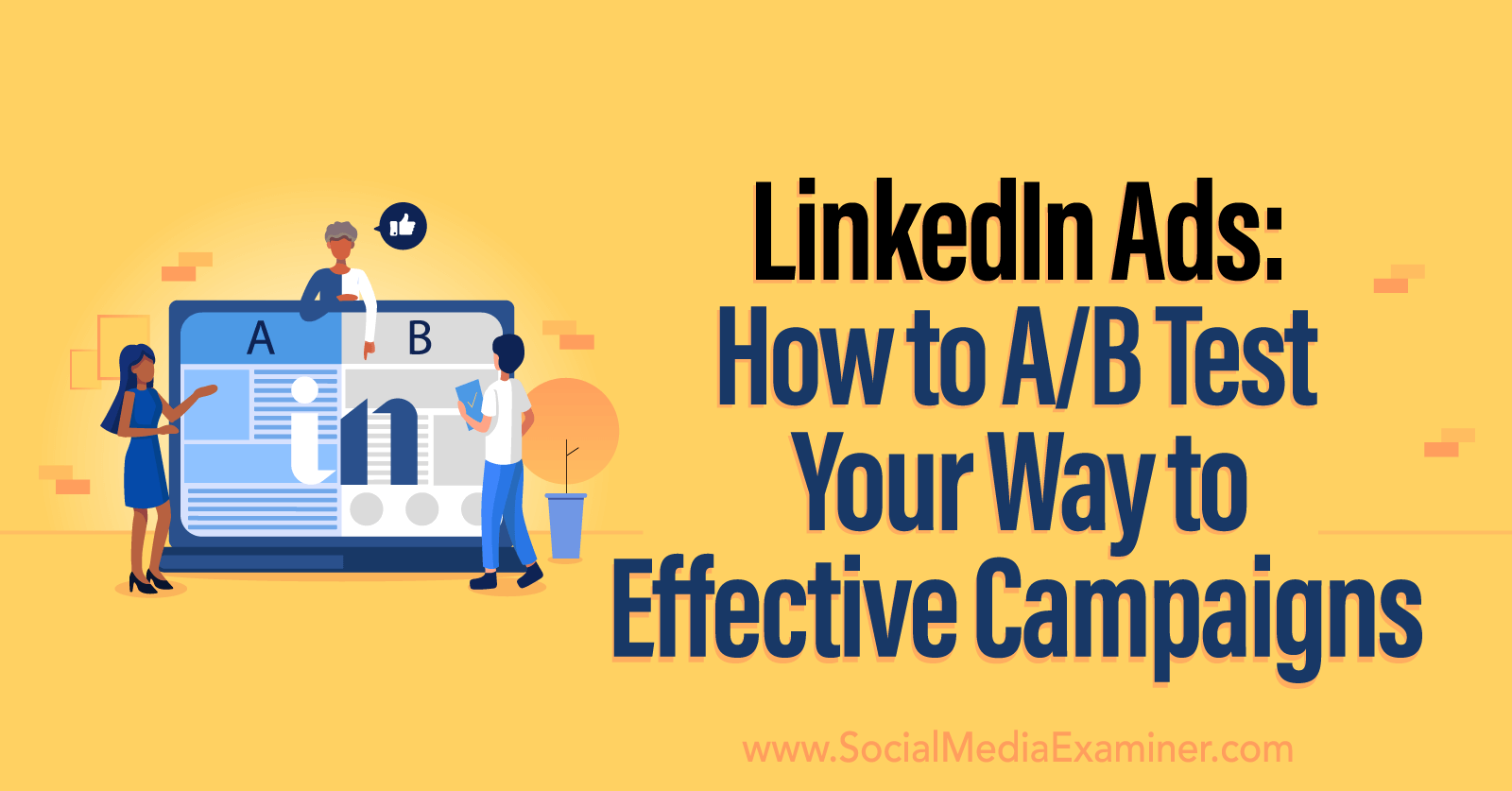
Why Split Testing Matters for LinkedIn Advertisers
Whether you’re launching a new offer or want to improve existing funnels, you need a way to test different campaign elements. By comparing various audiences, creatives, and offers against each other, you can make data-driven decisions about what works best—and ultimately where to invest your resources.
Many advertising platforms, including Meta Ads Manager and Google Ads, have built-in A/B testing tools. Yet for years, running experiments with LinkedIn ads hasn’t been particularly easy. Since LinkedIn Campaign Manager didn’t offer a split-testing tool until recently, advertisers have had to run test campaigns manually, which is hardly a foolproof process.
As of April 2023, however, Campaign Manager has a built-in A/B testing tool. Advertisers can now experiment with LinkedIn advertising campaign elements more reliably, identify what delivers the best results, and create more cost-effective paid promotions.
How is the A/B testing tool different from simply running two campaigns against each other? LinkedIn Campaign Manager states that A/B tests take place in a statistically valid environment. Although some members may see both versions of the test, the platform has determined that this potential effect isn’t significant.
Campaign Manager supports testing:
- Ads, including creatives, copy, and formats
- Audiences, including various targeting strategies
- Placements, including the LinkedIn Audience Network
How to Run an A/B Test in LinkedIn Campaign Manager
To start an A/B test, open LinkedIn Campaign Manager and go to the Test tab. Click the Create Test button to open the drop-down menu, and select A/B Test.
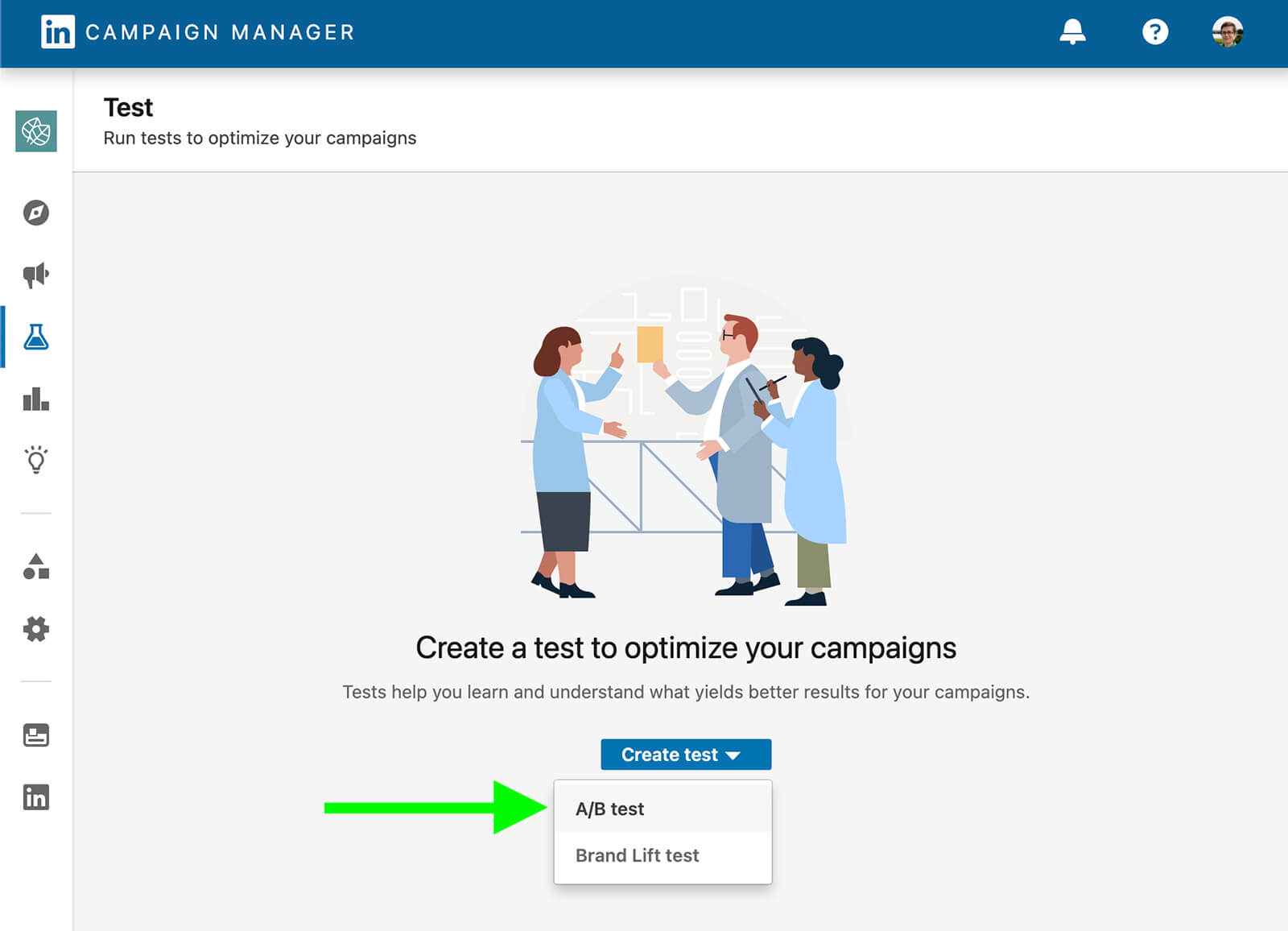
#1: Configure the A/B Test Settings
First, give the A/B test a name that you can easily differentiate from a standard campaign. For example, you might use your campaign naming structure, followed by A/B Test – [Variable] so you can easily identify it as a split test.
Then choose the variable you plan to test. LinkedIn’s A/B testing tool lets you experiment with one variable at a time, using campaigns that are identical, aside from this variable element.
Next, set either a lifetime or a daily budget for the A/B test. Campaign Manager automatically divides the budget you set into two to spend equal amounts on each test version. You don’t have to adjust the budget or traffic per test version but you should give each one a name that fits with your account’s standard naming structure.
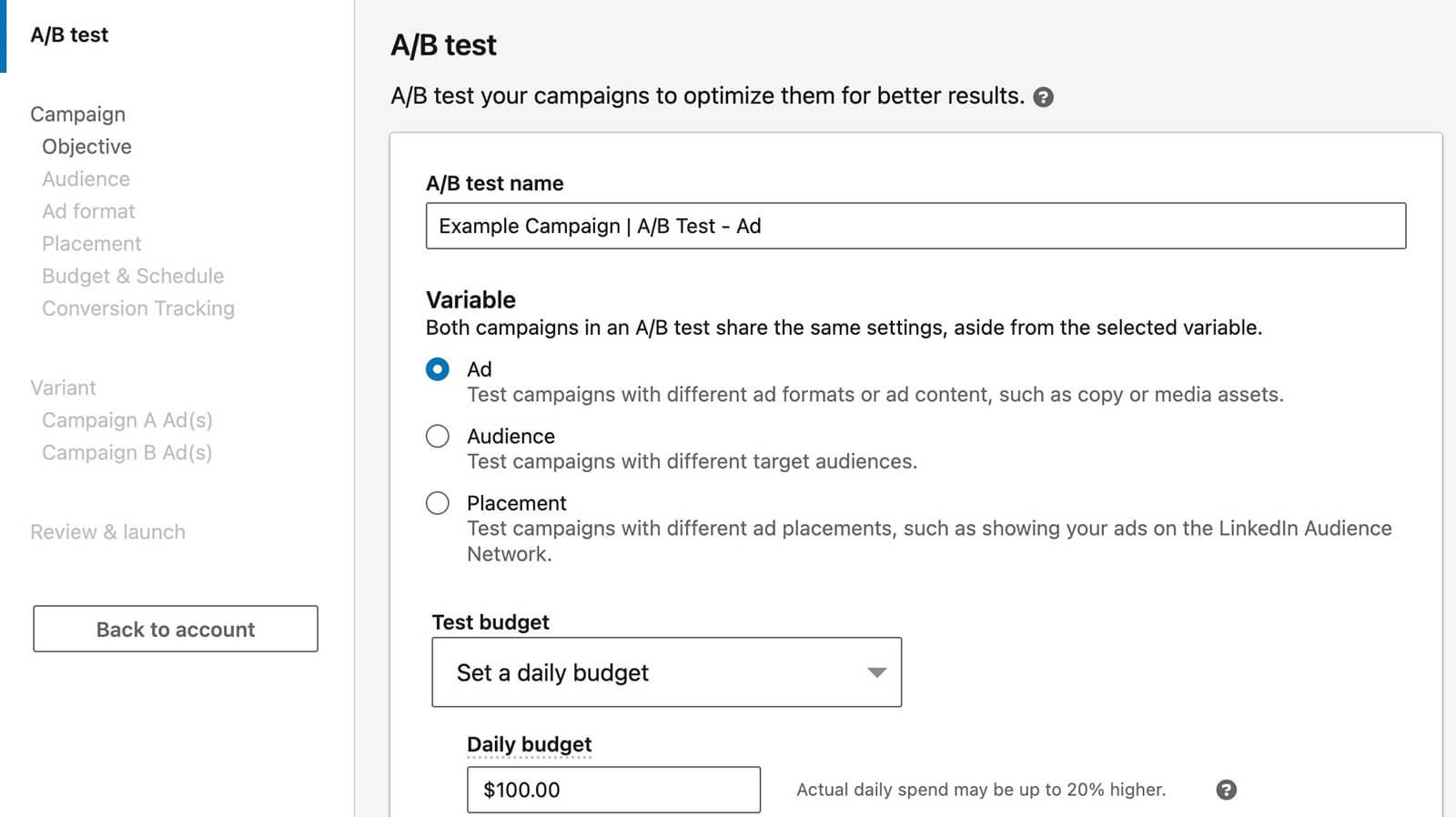
Finally, set a schedule for the A/B test. By default, Campaign Manager sets A/B tests to run for 2 weeks. While you can adjust the start and end dates manually, the minimum amount of time to schedule for an A/B test is 2 weeks.

#2: Set Up the Test LinkedIn Ad Campaigns
After choosing A/B test settings, you’re ready to build the two test ad campaigns. If you’re accustomed to using Campaign Manager, the setup interface should look familiar, aside from one key difference.
Because the two campaign versions should be identical aside from the test variable, you only have to choose the shared settings once. Campaign Manager automatically applies them to both versions. Then you can set up the variable elements for each campaign.
Get World-Class Marketing Training — All Year Long!
Are you facing doubt, uncertainty, or overwhelm? The Social Media Marketing Society can help.
Each month, you’ll receive training from trusted marketing experts, covering everything from AI to organic social marketing. When you join, you’ll also get immediate access to:
- A library of 100+ marketing trainings
- A community of like-minded marketers
- Monthly online community meetups
- Relevant news and trends updates
Campaign Objective
To configure the shared settings, start by selecting the objective you’ll use for both campaigns. Then choose the test metric that LinkedIn will use to determine the winning campaign. Options vary depending on the campaign objective.
Target Audience
Next, build the target audience for both campaigns. You can repurpose saved audiences, use your website or LinkedIn company page data, or create new attributes-based audiences. If you’re split testing audiences, then you’ll choose targeting when configuring the test variants rather than during the campaign setup process.

Ad Formats
Then choose the ad format for your two campaigns. If you’re split testing ads, you’ll have an option to choose two different formats to test; video ads, carousel ads, conversation ads, message ads, dynamic ads, and so on. You can uncheck this box if you want to A/B test two creatives that use the same format.

Ad Placement
Next, select placements for your test campaigns. In addition to running them on available placements across LinkedIn, you can also opt to place campaigns on the LinkedIn Audience Network, which includes third-party websites and mobile apps. Note that if you’re testing ad placements, you’ll choose these settings when setting up the test variants.
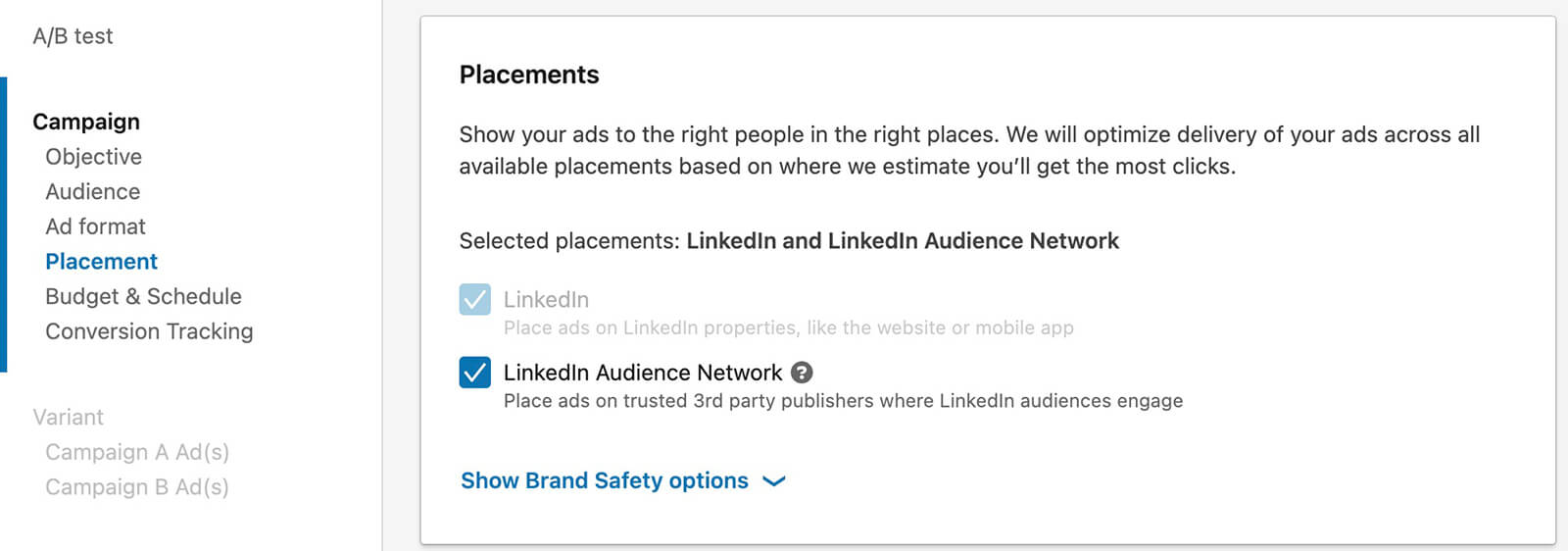
Optimization and Bidding Strategy
Since you already chose the budget and schedule during the A/B test setup, these settings carry over automatically and can’t be changed at the campaign level. However, you can adjust the optimization goal and bidding strategy to align with your goals. Note that these options vary based on your campaign objective.

Conversion Tracking
You also have the option to enable conversion tracking for your A/B tests. Although conversion tracking isn’t required, it’s important for measuring outcomes using the LinkedIn Insight Tag. For example, you can track ad views, URL clicks, lead magnet downloads, form submissions, and other conversions.
If you haven’t already set up relevant conversions for your account, you can click to create a new one directly from the A/B test interface. Just define the type of conversion you want to track, set a value if applicable, and choose an attribution model. Then enter the tracking details such as the URL where the conversion takes place.
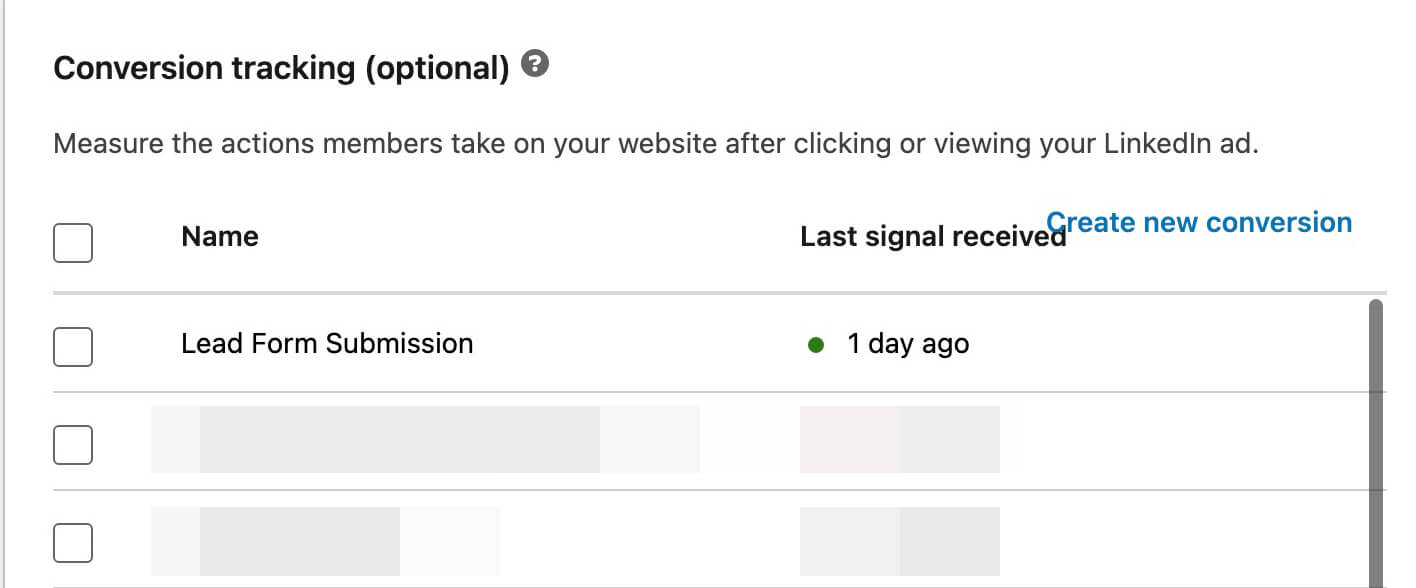
#3: Design the Ad
If you’re testing ads, skip ahead to the next step to begin building variants for each version of the split test. But if you’re A/B testing audiences or placements, the next step is designing an ad to use across both versions. Just like a standard ad, you’ll need to select an imageor video, write a headline, craft a caption, and choose a call to action.

Similar to Campaign Manager’s standard creative workflow, you can either browse existing content or design a new ad. Whether you opt to use existing content or build from scratch, note that Campaign Manager recommends adding five ads for optimal performance. However, multiple creatives aren’t always optimal for A/B tests (see best practices below).

#4: Build the A/B Test Variants
The variant setup process looks a little different depending on the campaign element you opt to test. Let’s take a closer look at each variant type.

Discover Proven Marketing Strategies and Tips
Want to go even deeper with your marketing? Check out the Social Media Marketing Podcast! Publishing weekly since 2012, the Social Media Marketing Podcast helps you navigate the constantly changing marketing jungle, with expert interviews from marketing pros.
But don’t let the name fool you. This show is about a lot more than just social media marketing. With over 600 episodes and millions of downloads each year, this show has been a trusted source for marketers for well over a decade.
How to A/B Test LinkedIn Ads
To split test ad creatives, clarify what question you want the experiment to answer. For example, are you curious which offer or messaging will resonate better with your audience? Are you wondering whether images or videos perform better with your ideal customer? Do you want to test different landing pages?
Use your answer to guide the variants you build. Technically, you can create two completely different ads with separate sets of headlines, captions, creatives, and landing pages. But it’s best to make the variants as similar as possible, aside from the element you want to test. In the example above, the variants are similar aside from the format.
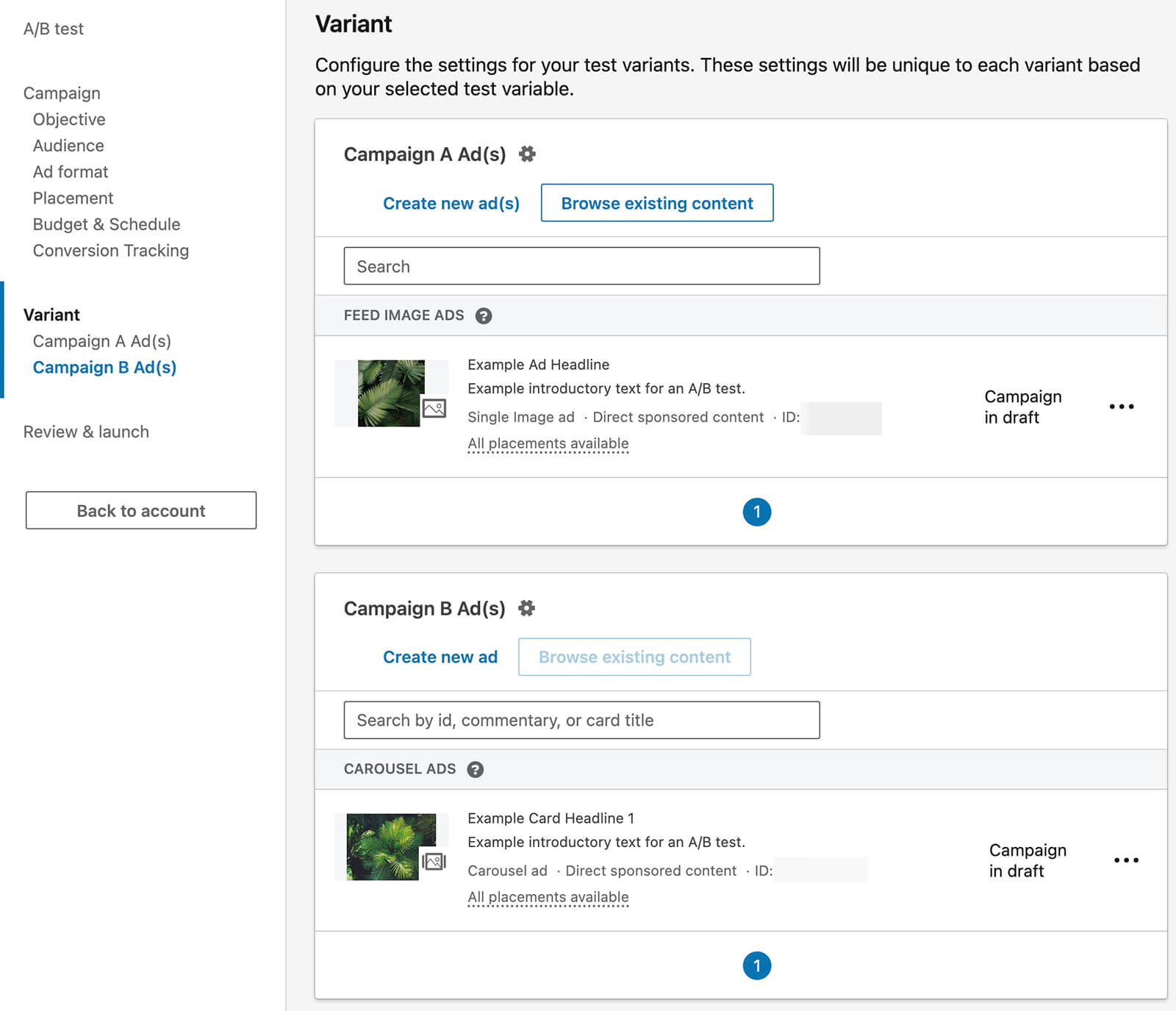
How to A/B Test LinkedIn Placements
Because LinkedIn’s ad placement controls are somewhat limited, you won’t see options to split test placements within the app. However, you can test A/B placements on the LinkedIn Audience Network.
For example, you can compare results from campaigns placed on LinkedIn only versus campaigns that run on LinkedIn and the LinkedIn Audience Network. You can also A/B test different brand safety options to see which gives you the most control without compromising performance.

Note that Campaign Manager’s brand safety settings apply to the LinkedIn Audience Network only. Using these settings, you can exclude categories of third-party websites and mobile apps or you can upload publisher lists to block.
Keep in mind that not every ad objective works with the LinkedIn Audience Network. For example, you won’t be able to test placements for lead generation campaigns, as this objective doesn’t support the LinkedIn Audience Network.
How to A/B Test LinkedIn Audiences
When you opt to test audiences, you’ll set up targeting for the two variants before selecting shared campaign settings. You have the option to choose from your own saved audiences, LinkedIn-generated audiences, and newly created audiences.
If you opt to build new audiences, you can access all of the same targeting tools that the standard Campaign Manager interface offers. That means you can create audiences based on attributes, leverage retargeting audiences, or use your own data for targeting. You also have the option to exclude select audiences to fine-tune your targeting.
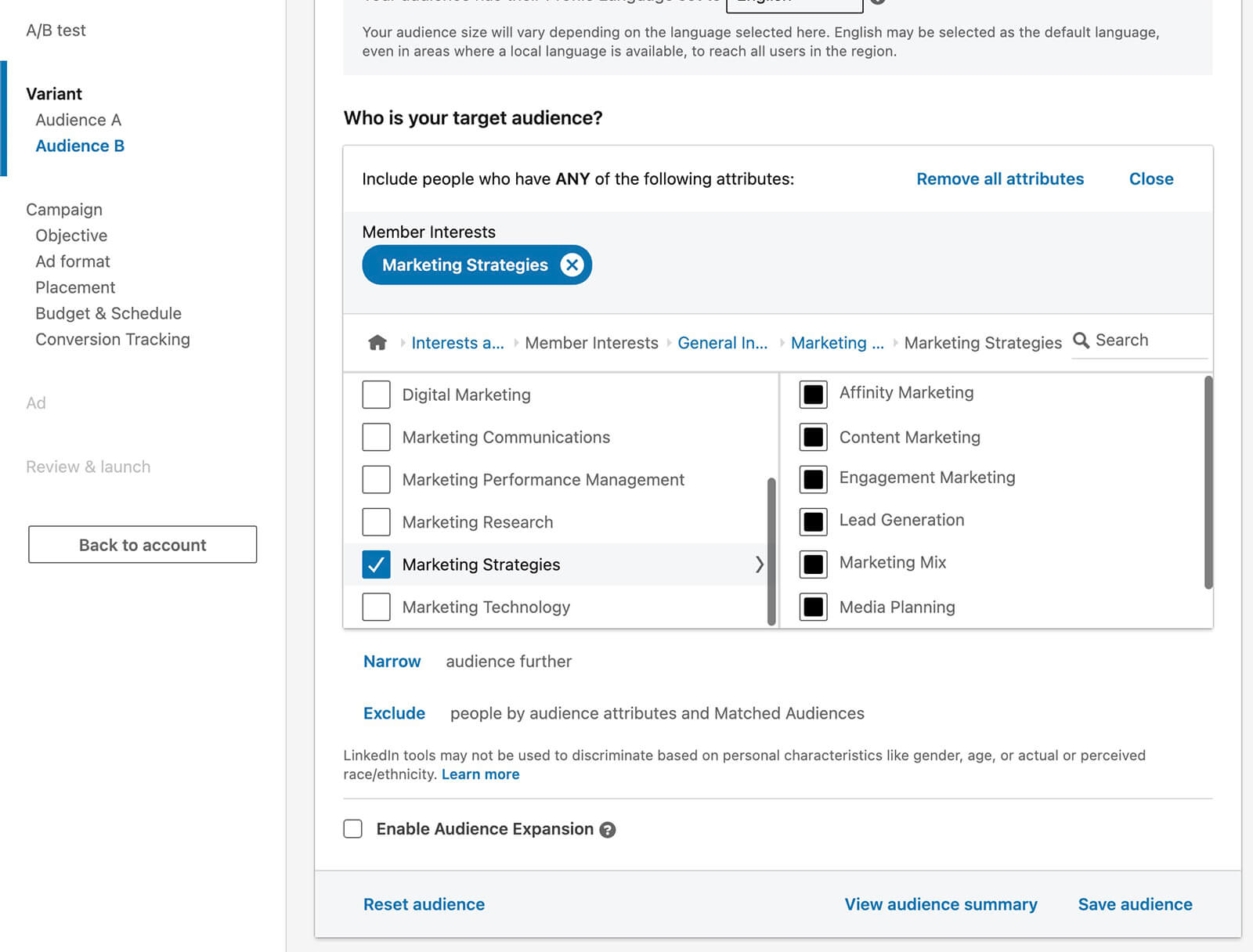
For best results, compare audiences that have minimal overlap. That way, you can compare the two while still getting statistically significant results from your split test.
Best Practices for A/B Testing LinkedIn Ads
LinkedIn’s A/B testing tool has a few quirks. To ensure that your split tests deliver useful results, keep these best practices in mind.
Frame the Test With a Hypothesis
Before setting up an A/B test, pinpoint what you want to learn and what you anticipate the outcome will be. For example, maybe you want to know whether your campaign performs better when you adjust the audience targeting—specifically, from company targeting to contact targeting.
Based on previous Linkedin advertising campaigns you’ve run, you can then state what you anticipate happening after the change. When you run the A/B test and review the data, you can confirm whether your hypothesis was correct. And either way, you can use the results to optimize future campaigns.

By framing an A/B test with a question and a hypothesis, you can ensure you’re experimenting with the right variables and using the best possible setup. You’ll also be better positioned to apply what you’ve learned to other campaigns.
Cross-Check Test Metrics
Available A/B test metrics change depending on the campaign objective you choose. To get useful data and choose the right winning variant, it’s important to select the most relevant metric for your split test.
But in some cases, you may not be able to use a test metric that aligns with the ultimate goal of your campaign. For example, LinkedIn’s A/B testing tool doesn’t support bottom-of-funnel metrics like cost per lead or cost per conversion. So you may end up using the next best option, like cost per click.

Keep in mind that the winning campaign may have the lowest cost per click but it may not have the most conversions or the lowest cost per conversion. To evaluate the results of your A/B test effectively, take time to dive deeper into LinkedIn Campaign Manager metrics and cross-check against other tools like Google Analytics.
Allow Enough Time for Split Testing
If you regularly run split tests on other ad platforms, you might be used to allotting a week or less to these experiments. For example, Meta recommends allowing 7 days for an A/B test across Facebook and Instagram but there’s no minimum requirement.
LinkedIn works a little differently. Split tests have to run for at least 14 days and they can remain active for up to 90 days. Have you set a goal to achieve specific results by a certain day? If you’re planning to start with a split test, make sure to allow at least 2 weeks for the experiment to run its course and determine a winner before launching the campaign.
Pay Attention to Audience Size
If you opt to split test audiences, pay close attention to the estimated size of each variant. Use the A/B Test Summary window at the top or in the right-hand sidebar to monitor audience sizes. Both should be above LinkedIn’s recommended minimum size, which is 300,000 for sponsored content and sponsored messaging.
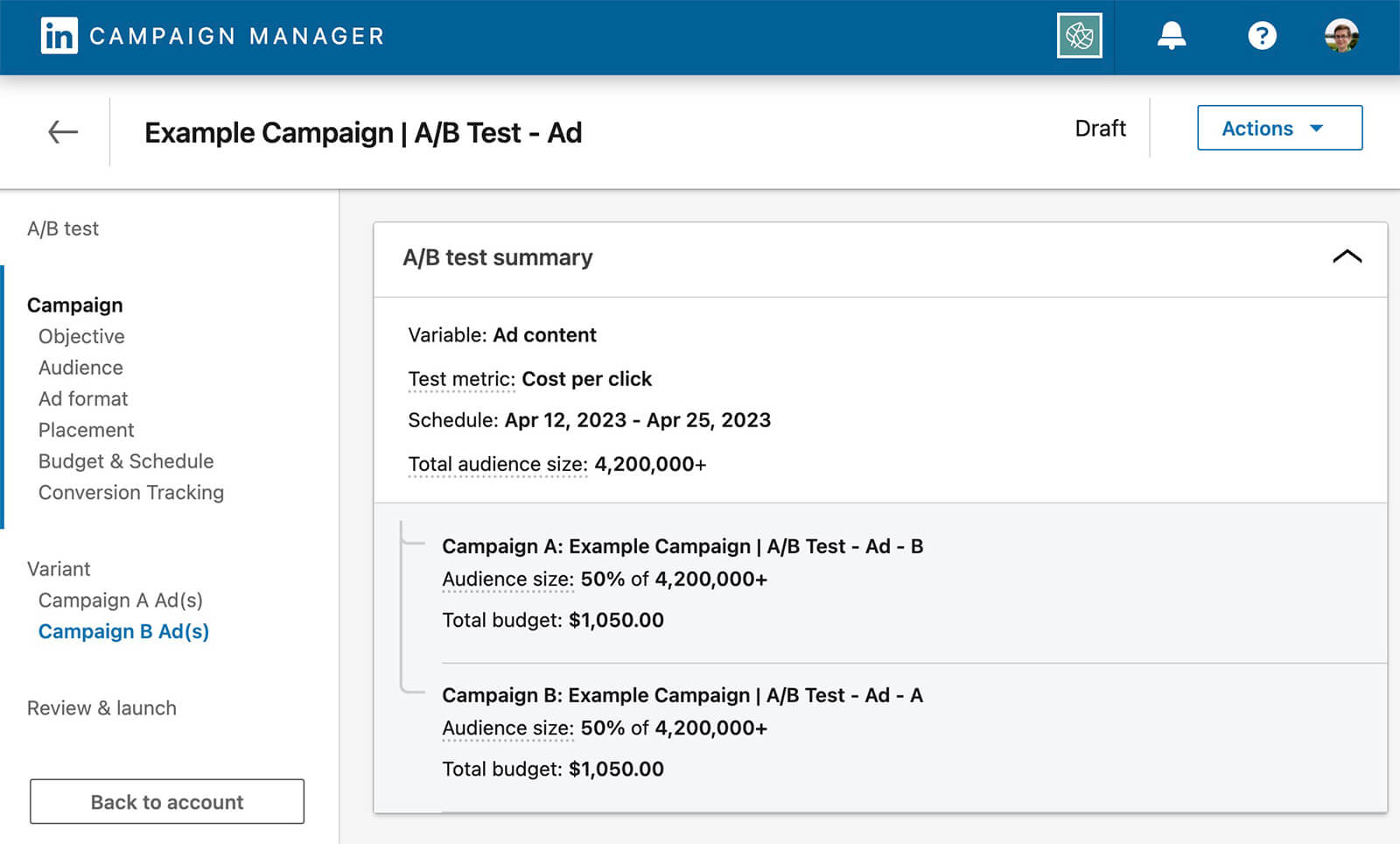
Should you enable LinkedIn’s Audience Expansion for A/B test variants? If your base audience size is too small for split testing, enabling Audience Expansion can help you reach more people. Just keep in mind that Audience Expansion is designed to improve delivery but it can decrease targeting precision.
Allocate Ample A/B Testing Budget
When you have a limited campaign budget, split testing may not be realistic. LinkedIn requires A/B tests to have at least a $10 daily or $700 lifetime budget. But keep in mind that these amounts are minimum requirements.
LinkedIn’s A/B testing budget recommendations are much higher. The platform recommends using a lifetime budget of $2,000 for an audience of 2 million or more. For smaller audiences of up to 1 million, LinkedIn recommends a lifetime budget of $10,000.
Plan to Leverage Winning Variants
When the split test concludes, the two campaign variants pause so you can review and act on the results. In many cases, you’ll want to keep running the winning variant so you can continue to get optimal results. Note that LinkedIn considers using winning ad sets statistically valid only when you continue to run them without making edits.
But you may be able to apply the results to other campaigns and ads across LinkedIn. For example, you can take what you’ve learned about audiences, placements, and ad creatives to similar ads and campaigns. If you suspect that this approach isn’t achieving optimal results, be open to incorporating A/B testing into more campaigns.
Know When to Optimize for Performance
A/B testing can be incredibly useful but it’s not always the best option for optimizing LinkedIn ads. For example, you may need to launch a LinkedIn campaign right away with a small budget but you may not know which creative to use.
To optimize LinkedIn ad creatives without running A/B tests, consider using Campaign Manager’s ad rotation options instead. You can choose to optimize ads for performance, which automatically identifies and delivers your best-performing ads.

Conclusion
For LinkedIn advertisers, split testing has long required manual workarounds. With Campaign Manager’s new A/B testing tool, advertisers can now compare campaigns based on ads, audiences, or placements—ultimately identifying top-performing elements and allowing more efficient optimization for your LinkedIn advertising.
Stay Up-to-Date: Get New Marketing Articles Delivered to You!
Don't miss out on upcoming social media marketing insights and strategies! Sign up to receive notifications when we publish new articles on Social Media Examiner. Our expertly crafted content will help you stay ahead of the curve and drive results for your business. Click the link below to sign up now and receive our annual report!
Attention Agency Owners, Brand Marketers, and Consultants

Introducing the Marketing Agency Show–our newest podcast designed to explore the struggles of agency marketers.
Join show host and agency owner, Brooke Sellas, as she interviews agency marketers and digs deep into their biggest challenges. Explore topics like navigating rough economic times, leveraging AI, service diversification, client acquisition, and much more.
Just pull up your favorite podcast app, search for Marketing Agency Show and start listening. Or click the button below for more information.

